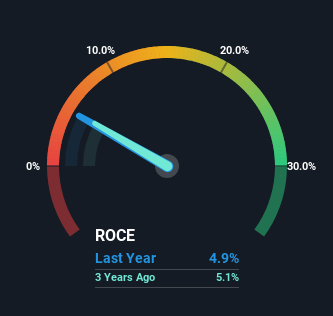- China
- /
- Construction
- /
- SHSE:601669
Returns On Capital At Power Construction Corporation of China (SHSE:601669) Have Stalled

To find a multi-bagger stock, what are the underlying trends we should look for in a business? Typically, we'll want to notice a trend of growing return on capital employed (ROCE) and alongside that, an expanding base of capital employed. Put simply, these types of businesses are compounding machines, meaning they are continually reinvesting their earnings at ever-higher rates of return. However, after investigating Power Construction Corporation of China (SHSE:601669), we don't think it's current trends fit the mold of a multi-bagger.
What Is Return On Capital Employed (ROCE)?
Just to clarify if you're unsure, ROCE is a metric for evaluating how much pre-tax income (in percentage terms) a company earns on the capital invested in its business. Analysts use this formula to calculate it for Power Construction Corporation of China:
Return on Capital Employed = Earnings Before Interest and Tax (EBIT) ÷ (Total Assets - Current Liabilities)
0.049 = CN¥32b ÷ (CN¥1.2t - CN¥594b) (Based on the trailing twelve months to June 2024).
Thus, Power Construction Corporation of China has an ROCE of 4.9%. On its own, that's a low figure but it's around the 5.7% average generated by the Construction industry.
View our latest analysis for Power Construction Corporation of China

In the above chart we have measured Power Construction Corporation of China's prior ROCE against its prior performance, but the future is arguably more important. If you're interested, you can view the analysts predictions in our free analyst report for Power Construction Corporation of China .
What The Trend Of ROCE Can Tell Us
In terms of Power Construction Corporation of China's historical ROCE trend, it doesn't exactly demand attention. The company has consistently earned 4.9% for the last five years, and the capital employed within the business has risen 59% in that time. This poor ROCE doesn't inspire confidence right now, and with the increase in capital employed, it's evident that the business isn't deploying the funds into high return investments.
Another thing to note, Power Construction Corporation of China has a high ratio of current liabilities to total assets of 48%. This can bring about some risks because the company is basically operating with a rather large reliance on its suppliers or other sorts of short-term creditors. Ideally we'd like to see this reduce as that would mean fewer obligations bearing risks.
The Key Takeaway
In summary, Power Construction Corporation of China has simply been reinvesting capital and generating the same low rate of return as before. And with the stock having returned a mere 15% in the last five years to shareholders, you could argue that they're aware of these lackluster trends. Therefore, if you're looking for a multi-bagger, we'd propose looking at other options.
If you'd like to know more about Power Construction Corporation of China, we've spotted 2 warning signs, and 1 of them doesn't sit too well with us.
While Power Construction Corporation of China may not currently earn the highest returns, we've compiled a list of companies that currently earn more than 25% return on equity. Check out this free list here.
New: Manage All Your Stock Portfolios in One Place
We've created the ultimate portfolio companion for stock investors, and it's free.
• Connect an unlimited number of Portfolios and see your total in one currency
• Be alerted to new Warning Signs or Risks via email or mobile
• Track the Fair Value of your stocks
Have feedback on this article? Concerned about the content? Get in touch with us directly. Alternatively, email editorial-team (at) simplywallst.com.
This article by Simply Wall St is general in nature. We provide commentary based on historical data and analyst forecasts only using an unbiased methodology and our articles are not intended to be financial advice. It does not constitute a recommendation to buy or sell any stock, and does not take account of your objectives, or your financial situation. We aim to bring you long-term focused analysis driven by fundamental data. Note that our analysis may not factor in the latest price-sensitive company announcements or qualitative material. Simply Wall St has no position in any stocks mentioned.
About SHSE:601669
Power Construction Corporation of China
Offers engineering contracting services in the People's Republic of China and internationally.
Acceptable track record with mediocre balance sheet.


